essay | images | figures | chronology | sponsors
CHRONOLOGY
COMPILED BY MIZUHO KATO
1932 – 1955 | 1956 – 1959 | 1960 – 1969 | 1970 – 2004
Entries are ordered chronologically, with each entry consisting of: date; exhibition/event title, venue; additional venues, if any; and works included. Titles of exhibitions/events and literature are given in Western languages only; many original Japanese titles may be found in the catalogue bibliography.
Narrative details are selectively given to contextualize the artist’s life and work.
1932
FEBRUARY 10
Atsuko Tanaka is born to Ishimatsu and Tami Tanaka at 1–3 Kita Horie Kamido¯ri, Nishi-ku, Osaka. Tanaka has four older sisters and four older brothers. Tanaka’s father, Ishimatsu, runs a match manufacturing company.
1945
Around 1945, the Tanakas move to 36 Obase Nishinomachi, Tenno¯ji-ku, Osaka.
1950
FEBRUARY
Tanaka enters the Art Institute of Osaka Municipal Museum of Art (Osaka Shiritsu Bijutsukan Fusetsu Bijutsu Kenkyu¯jo), in
preparation for art school entrance exams. Her fellow students include Akira Kanayama and Kazuo Shiraga, who precede her at
the institute.
1951
APRIL
Tanaka enters the Department of Western Painting at Kyoto Municipal College of Art (Kyoto Shiritsu Bijutsu Daigaku), which is now known as Kyoto City University of Arts (Kyoto Shiritsu Geijutsu Daigaku).
FALL
Tanaka leaves the school and goes back to the Art Institute of Osaka Municipal Museum. Although she has worked primarily in a figurative mode, she begins to explore a new direction on Kanayama’s advice.
1953–54
Tanaka is hospitalized due to poor health. At the hospital, eagerly counting the days until her discharge, she writes down numbers and draws along their contours with crayon. When she sees them, she realizes they are painting.
Shortly after her discharge, while recuperating at home, she creates the Calendar collages (c. 1954, plates 1, 2) made from shipping waybills, which Kanayama is using in his work. She subsequently produces a series with number motifs.
Through Kanayama, she comes to know Zero Society (Zero-kai), which was founded in the fall of 1952 by young, innovative artists, including Kanayama, Shiraga, and Saburo¯ Murakami. She attends the group’s regular meetings held at Kanayama’s house at the temple Myo¯ho¯ji, located at Tanimachi 8-cho¯me, Minami-ku, Osaka.
1954
OCTOBER
Zero Society Exhibition, Sogo¯ department store, Osaka.
Works included in this one-week exhibition: the first “number” work simply entitled Work (c.1954, plate 3).
DECEMBER
Sho¯zo¯ Shimamoto begins to attend Zero Society’s regular meetings. Reportedly, Shimamoto is impressed by Tanaka’s Work (6) (1955, plate 5). He asks the members to join the Gutai group.
1955
SPRING
Tanaka joins Gutai, together with Kanayama, Shiraga, and Murakami.
JUNE 8–12
8th Ashiya City Exhibition, auditorium of Seido¯ Elementary School
Works included: 3
Three works from 1955; each entitled Work and made of yellow cotton fabric cut in the shape of a circle, square, and rectangle. Each consists of a few sheets of cloth—three for the circular one, and two each for the square and the rectangular ones—cut to almost the same size, layered with a slight misalignment between sheets, and glued together. Though initially rejected, these panels are included in the exhibition on the recommendation of Jiro¯ Yoshihara, a juror and Gutai’s leader.
The June 9 article of the Mainichi shinbun, “Highlighting Something Out of the Ordinary,” quotes: “Gimmickry does not make genuine work. [These works] are the result of
thinking through how to handle the fabric, how to handle it in truly my own way. I want to create something that drastically deviates from ordinary painting.”
JULY 25–AUGUST 6
Experimental Outdoor Exhibition of Modern Art to Challenge the Midsummer Sun, Ashiya Park, Ashiya
Works included: 5
1) Untitled (1955); a 10-metre square of pink rayon cloth, trimmed along the edges with a 5-centimetre-wide band of blue fabric, is floated at the height of 30 centimetres (fig. 3). 2) Untitled (1955); a 2-metre square of galvanized sheet iron, painted in fluorescent red, is erected perpendicular to the ground. 3) Yellow Wood (1955) consists of 17 cedar planks, each approximately 1.8 metres long, which are joined and hung from an approximately 6-metre-high pole. 4) Untitled (1955); 35 pieces of wood, painted in Prussian blue, are joined by clamps and attached to the top of an approximately 3-metre-high pole, parallel to the ground. 5) Untitled (1955); several pieces of cloth, each painted fluorescent blue and stretched over a wire ring, 25 centimetres in diameter, are hung at the approximate height of 5 metres.
The Industrial Economic News quotes Tanaka in the July 25 article, “Talking About a Motif”: “I wanted to shatter stable beauty with my work. In the case of the pink fabric the size of twenty tatami mats (about 10 x 10 metres), I wanted to use the most distasteful colour imaginable. I walked all over the city of Osaka and finally found this rayon. I wanted to destroy the superficiality of the conventional ‘artistic look,’ using the weird sheen that resulted from sunlight reflecting from the cloth covering the ground.”
OCTOBER 19–28
1st Gutai Art Exhibition, Ohara Kaikan hall, Tokyo
Works included: 10
Work (6) (1955, plate 5); seven Work[s] (Yellow Cloth) (1955, plates 6, 7, 8); one work of pink rayon with blue trim along the edges (1955); Work made of green rayon, with metal net rolled up like a cushion and placed at the centre (1955); and Work (Bell) (1955, plate 15).
NOVEMBER 24–28
3rd Genbi Exhibition, Kyoto Municipal Museum of Art
Travels to: Asahi Building Hall, Ko¯be (December 1–5) and Osaka Municipal Museum of Art (December 13–19).
Works included: 6
Work[s] (Yellow Cloth) (1955) made of four yellow cotton fabric panels (plates 6, 7, 8); Work (1955) made of green rayon fabric; and Work (Bell) (1955, plate 15).
In the November 24 article, the Asahi shinbun introduces her statement under the headline, “Twenty Bells Take You by Surprise: A Young Lady’s Work Accepted to Genbi’s Exhibition Without Problem”:
“The bell work consists of a forty metre electric cable installed in the gallery, with twenty bells attached to it. I designed it so that the bells, controlled by a motor, automatically ring sequentially. I aimed at the effect of sound diminishing as it moves farther away. With the yellow fabric, the fine seams may not
visibly amount to that much, but I devised my own seaming method. So in a larger sense, it’s a composition.”
1956
APRIL 4
On behalf of Life magazine, the correspondent Jean Launois of Pana News Service and reporter William Payne of Life’s Singapore Bureau come to Osaka. They photograph
the first version of Tanaka’s costume-changing work (fig. 15) at Yoshihara’s vegetable oil
factory in the Imazu section of Nishinomiya.
APRIL 9
One-Day Outdoor Exhibition, held at the ruins near the mouth of Muko River, Amagasaki.
The exhibition is organized for a photo-essay on the Gutai for Life magazine. It is never
published.
Works included: 1
Untitled (1956); made with pink rayon fabric.
MAY 1–8
Shinko¯ Independent Exhibition, Shinko¯ Newspaper Company, Ko¯be
The “Gutai Group Room” is presented as part of the Second Section: Sculpture on the third floor.
Works included: 1
Work (Red Dress) (1956, plate 21); dress of red rayon, with a “hand,” “leg,” and “foot”
in yellow fabric on one side, and green on the other.
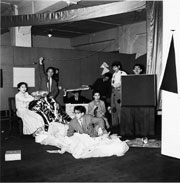
Shinko Independent Exhibition (Shinko shinbun, Kobe, May 1956).
In front, Toshio Yoshida. Back row (left to right): Atsuko Tanaka,
Yasuo Sumi, Saburo Murakami, Tsuruko Yamazaki, Yozo Ukita,
Sadamasa Motonaga, Shozo Shimamoto. The long red dress hanging
from the ceiling is Tanaka's Work (Red Dress).
© The former members of the Gutai. Courtesy of the Ashiya City Museum of Art
& History.
JUNE 8–12
9th Ashiya City Exhibition, auditorium of Seido¯ Elementary School
Works included: 3
Three Untitled paintings (1956, plates 17, 18, 19). Each painting is dominated by a large, scribbled geometric form, over which a large X is aggressively marked.
JULY 27–AUGUST 5
Outdoor Gutai Art Exhibition, Ashiya Park, Ashiya
Works included: 2
Stage Clothes (1956) and Work (Cross) (1956).
In the Yomiuri shinbun’s August 3 article on the exhibition, subtitled, “It’s Interesting Because It Moves,” Tanaka explains: “[This is] one of many stage dresses—some of them change colours when I stand on my hands, some come apart. Previously, the dresses were illuminated, but this time the dress itself emits light. With the blinking lights, I aimed at an engaging effect of speed, form, colour, and motion.”
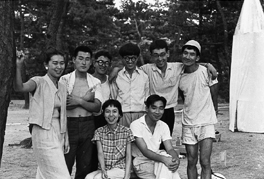
Outdoor Gutai Art Exhibition (Ashiya Park, July 1956).
Front row (left to right): Atsuko Tanaka, Yozo Ukita. Back row
(left to right): Tsuruko Yamazaki, Kazuo Shiraga, Shozo Shimamoto,
Saburo Murakami, Akira Kanayama, Sadamasa Motonaga.
© The former members of the Gutai. Courtesy of the Ashiya City Museum of Art
& History.
OCTOBER 11–17
2nd Gutai Art Exhibition, Ohara Kaikan hall, Tokyo
Works included: 21
Electric Dress (1956, plate 28), Untitled (1) (1956, plate 29), Untitled (3) (1956, plate 30), Untitled (5) (1956, plate 31), Untitled (6) (1956, plate 32), Untitled (8) (1956, plate 34), and three Drawing[s] after “Electric Dress” (1956, plates 37, 38, 39).

2nd Gutai Art Exhibition (Ohara Kaikan hall, Tokyo, October 1956). Tanaka installing Electric Dress.
© Atsuko Tanaka. Courtesy of Atsuko Tanaka and the Ashiya City Museum of Art & History.

2nd Gutai Art Exhibition (Ohara Kaikan hall, Tokyo, October 1956). Tanaka wearing Electric Dress (1956), enamel paint on light
bulbs, electric cords, and control console, approximately 165 x 80 x 80 cm (not extant). © Atsuko Tanaka and the former members
of the Gutai. Courtesy of the Ashiya City Museum of Art & History

2nd Gutai Art Exhibition (Ohara Kaikan hall, Tokyo, October 1956).Tanaka and Electric Dress.
© Atsuko Tanaka and the former members of the Gutai.
Courtesy of the Ashiya City Museum of Art & History.

2nd Gutai Art Exhibition (Ohara Kaikan hall, Tokyo, October 1956). Electric Dress and twenty
drawings related to Electric Dress.
© Atsuko Tanaka and the former members of the Gutai.
Courtesy of the Ashiya City Museum of Art & History.
1957
APRIL 3–10
3rd Gutai Art Exhibition, Kyoto Municipal Museum of Art
Works included: 4
All Electric Dress[es] (1956 and 1957).
MAY 29
Gutai Art on the Stage, Sankei Kaikan hall, Osaka
Travels to: Sankei Hall, Tokyo (May 17).
Works included: 4
Tanaka’s contribution to Gutai Art on the Stage consisted of Stage Clothes, a dress-changing performance in front of Work (Red Dress),
followed by three Electric Dress[es] shown at the 3rd Gutai Art Exhibition.
In the programme, Tanaka explains: “This stage dress changes colour in an unexpected manner, from red to yellow to blue. In the end it becomes an electric dress, which blinks like fireworks.”

3rd Gutai Art Exhibition (Kyoto Municipal Museum of Art, April 1957). The exhibition included four works by Tanaka.
Electric Dress is second from the left. © Atsuko Tanaka.
Courtesy of the Ashiya City Museum of Art & History
SEPTEMBER 13
Michel Tapié, on his first trip to Japan, sees works by the Gutai members, including Tanaka’s, at Jiro¯ Yoshihara’s residence in Ashiya (fig 34).
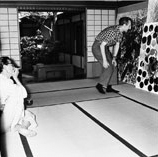
Michel Tapié looking at works by Gutai members installed at Jiro Yoshihara's home, September 13, 1957.
© The former members of the Gutai.
Courtesy of the Ashiya City Museum of Art & History.
OCTOBER 8–10
4th Gutai Art Exhibition, Ohara Kaikan hall, Tokyo
Works included: 7
Known works in exhibition: five pieces entitled Work[s] (1957, plates 49, 50, 51, 52, 53); another Work (1957) constructed from a disassembled Electric Dress; and one Untitled painting (1957) executed on a red vinyl sheet.
DECEMBER 16–22
Un Art Autre, Daimaru department store, Osaka
Works included: 1
Work (1957), a painting that Tapié saw at Yoshihara’s house.
1958
APRIL 4
2nd Gutai Art on the Stage, Asahi Kaikan hall, Osaka
Works included: 1
Work (5) (Luminous Discs and Dress) (1958) directed and performed by Tanaka.
In the accompanying flyer Tanaka writes:
“We always want a fresh sensibility. We are attracted to a simple, subtle, and intense sensibility. Luminous discs will intermittently change, so will a dress.”
APRIL 12–20
International Art of a New Era: Art Informel and Gutai, Takashimaya department store, Osaka.
The exhibition, organized as part of the Osaka International Arts Festival, travels to Nagasaki, Hiroshima, Tokyo, and Kyoto.
Works included: 2
Both entitled Work. One is painted on a 4.3 x 9 metre white, vinyl sheet (1958); the other is constructed with electric light bulbs (1958). The former is shown only in Osaka, and is replaced in the subsequent venues by the painting on a red vinyl sheet that was first shown at the 4th Gutai Art Exhibition.
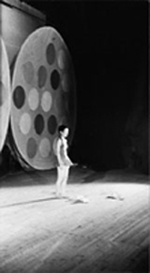
2nd Gutai Art on the Stage (Asahi Kaikan hall, Osaka, April 4, 1958). Tanaka performing Shining Disc and Clothes.
© Atsuko Tanaka and the former members of the Gutai.
Courtesy of the Ashiya City Museum of Art & History.
APRIL 30–MAY 2
5th Gutai Art Exhibition, Ohara Kaikan hall, Tokyo
Works included: 1
Untitled painting (1958)
SEPTEMBER 25–OCTOBER 25
6th Gutai Art Exhibition, Martha Jackson Gallery, New York
Travels to: Bennington, Vermont; Minneapolis, Minnesota; Oakland, California; and Houston, Texas.
Works included: 1
Untitled painting (1958)
1959
MAY 5–JUNE 15
Arte Nuova: Esposizione Internazionale di Pittura e Scultura, Circolo degli Artisti, Palazzo Graneri, Turin
Works included: 1
Untitled painting (1958)
JUNE
7th Gutai Art Exhibition, Galleria Arti Figurativi, Turin
Works included: 1
Untitled painting (c.1959)
AUGUST 25–30
8th Gutai Art Exhibition, Kyoto Municipal Museum of Art
Travels to: Ohara Kaikan hall, Tokyo (September 11–13)
Works included: 3
Two Untitled paintings (1958 and 1959), and one untitled, three-dimensional, spherical work, approximately 3 metres in diameter (1959).
SEPTEMBER 21–30
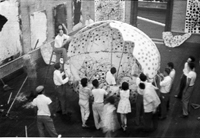
8th Gutai Art Exhibition (Kyoto Municipal Museum of Art, August 1959). Gutai members installing Untitled (1959), white cement, cord, and plastic spheres,
300 x 250 cm (not extant).
© The former members of the Gutai.
Courtesy of the Ashiya City Museum of Art & History.
15 Contemporary Artists Selected by Tapié, Gendai Gallery, Tokyo
Works included: 1
Untitled painting (c.1959)
1960
APRIL 19–24
International Sky Festival, Takashimaya department store rooftop, Osaka
Works included: 1
Like other participants’ drawings, her drawing is enlarged and reproduced in house paint on a calico sheet, and hung from an advertising balloon for an exhibition in the sky.
APRIL 19–24
9th Gutai Art Exhibition, Takashimaya department store, Osaka
The exhibition includes a specially designed event held in conjunction with the International Sky Festival.
Works included: 3
Two paintings (1960 and c.1960) and one festival-related preparatory drawing.
JUNE 7–12
13th Ashiya City Exhibition, auditorium of Seido¯ Elementary School
Works included: 2
Two Untitled paintings (both c. 1960)
Tanaka receives a mayor’s award.
Anthony Denney, a friend of Tapié’s and
collector of contemporary art, purchases three works by Tanaka.
1961
MARCH
Continuité et Avant-Garde au Japon, International Centre of Aesthetic Research, Turin
Works included: 1
Untitled painting (1959)
APRIL 11–16
10th Gutai Art Exhibition, Takashimaya department store, Osaka
Travels to: Takashimaya department store, Tokyo (May 2–7)
Works included: 6
Three paintings (all 1961) and one three-dimensional work, which consists of a metal net, to which plaster and plastic semi-spheric boxes were attached. In Tokyo, Tanaka adds two paintings (both 1961).
APRIL 12–30
Experiment in Contemporary Art, The National Museum of Modern Art, Tokyo
Works included: 4
Work A (1959), Work B (1960), Work C (1960), and Work D (1960).
FALL
XII Premio Lissone: Internazionale per la Pittura, Palazzo del Centro del Mobile, Lissone, Italy
Works included: 1
Untitled painting (1960)
1962
APRIL 17–22
11th Gutai Art Exhibition, Takashimaya department store, Osaka
Works included: 3
Three paintings; two Untitled works (both 1962); and Three Black Balls (1962,
plate 54).
APRIL 26–MAY 21
Structures de Répétition, Galerie Stadler, Paris
Works included: 2
Two Untitled paintings (1959 and 1961)
JUNE 18–AUGUST 5
Strutture e Stile, Galleria Civica d’Arte Moderna, Turin
Works included: 3
Each entitled Work (1958, 1960, and 1961) in the “Structures of Repetition” section.
NOVEMBER 6
Don’t Worry! The Moon Won’t Fall!: Gutai and Morita Modern Dance, Sankei Kaikan hall, Osaka
Works included: 1
Work (3) (Before the Pink Curtain) (1962) directed and performed by Tanaka with the dance company Morita Modern Dance.
1963
JANUARY 29–FEBRUARY 3
12th Gutai Art Exhibition, Takashimaya department store, Tokyo
Works included: 4
All Untitled: one from c.1962, three from 1963.
FEBRUARY 1–10, and Wednesdays thereafter (13, 20, and 27)
Atsuko Tanaka Exhibition, Gutai Pinacotheca, Osaka
Works included: 25
APRIL 16–21
13th Gutai Art Exhibition, Takashimaya department store, Osaka
Works included: 1
Untitled painting (1963)
APRIL 22–MAY 10
Atsuko Tanaka Exhibition, Minami Gallery, Tokyo
Works included: 23
Sam Francis is said to have recommended Tanaka to the gallery owner Kusuo Shimizu. From this exhibition, the American painter purchases a painting, which is then renamed Thanks Sam. As a token of gratitude, Tanaka makes a present of a Work to Francis (1957, plate 53).
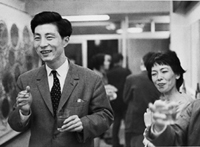
Atsuko Tanaka Exhibition (Minami Gallery, Tokyo, April 1963). From left, Toru Haga, Atsuko Tanaka.
Courtesy of Atsuko Tanaka and the Ashiya City Museum of Art & History.
MAY
At the request of Bijutsu Shuppan-sha, Tanaka paints the whole stretch of first floor glass windows of the art publisher’s building located in the Yotsuya section of Tokyo. It takes about ten days to complete the work.
 Tanaka standing in front of the first floor window of the office building of
Tanaka standing in front of the first floor window of the office building of
Bijutsu Shuppan-sha (Yotsuya, Tokyo, March 1966).
The painting on the window was completed in May 1963.
© Atsuko Tanaka and Akira Kanayama.
Courtesy of Atsuko Tanaka and the Ashiya City Museum of Art & History.
JUNE–JULY
Lawrence Alloway, curator of the Guggenheim Museum, visits the Gutai Pinacotheca while researching the following year’s Guggenheim International and sees Tanaka’s work.
JULY 5
Roland A. Gibson, an American collector of contemporary art, visits the Gutai Pinacotheca and sees Tanaka’s work. Beginning in 1965, Gibson actively purchases her large-scale works. One of the works that he purchased was shown in Resounding Spirit: Japanese Contemporary Art of the 1960s (Potsdam, N.Y.: Roland Gibson Gallery, SUNY, 2004), 92.
JULY 6–AUGUST 29
Trends of Contemporary Painting: The West and Japan, The National Museum of Modern Art, Kyoto
Works included: 2
Two paintings, each entitled Work (both 1963).
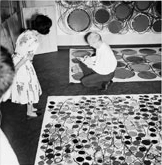
Curator Lawrence Alloway visiting the Gutai Pinacotheca, Osaka, to choose works for the Guggenheim International Award (summer 1963).
© The former members of the Gutai.
Courtesy of the Ashiya City Museum of Art & History.
1964
JANUARY 16–MARCH 29
Guggenheim International Award 1964, The Solomon R. Guggenheim Museum, New York
Works included: 1
Thanks Sam (1963)
MARCH 31–APRIL 5
14th Gutai Art Exhibition, Takashimaya department store, Osaka
Works included: 3
Work A, Work B, and Work C (all c. 1964)
MAY 10–30
6th Contemporary Art Exhibition of Japan, Tokyo Metropolitan Art Museum
Travels to: Osaka, Takamatsu, Kitakyu¯shu¯, and Sasebo
Works included: 1
Untitled (1964), now in the collection of the Museum of Modern Art, New York, included in the Invitational Section.
Tanaka receives an award of excellence for this work.

Tanaka standing in front of her work Untitled (1964), enamel paint on canvas, 333.4 x 225.4 cm, now in the collection of the
Museum of Modern Art, New York. Tanaka received an excellence award for this work at the
6th Contemporary Art Exhibition of Japan (Tokyo Metropolitan Art Museum, May 1964).
© Atsuko Tanaka and Akira Kanayama.
Courtesy of Atsuko Tanaka and the Ashiya City Museum of Art & History.
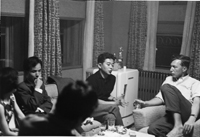
From right: Jasper Johns; Yoshiaki Tono, Toru Takemitsu, Atsuko Tanaka in Tokyo at the
6th Contemporary Art Exhibition of Japan (Tokyo Metropolitan Art Museum, May 1964).
© Akira Kanayama.
Courtesy of Atsuko Tanaka and the Ashiya City Museum of Art & History.
AUGUST 14–SEPTEMBER 4
Intuiciones y Realizaciones Formales, Centro de Artes Visuales del Instituto Torcuato Di Tella, Buenos Aires
Works included: 1
Untitled painting (1962)
NOVEMBER 29
William S. Lieberman, curator of the Museum of Modern Art, New York, encounters Tanaka’s work during a visit to the Gutai Pinacotheca, as part of his research for
The New Japanese Painting and Sculpture, scheduled for the following year at the San Francisco Museum of Art.
DECEMBER 1–27
Nagaoka Contemporary Art Museum Award Exhibition, Nagaoka Contemporary Art Museum, Nagaoka
Works included: 3
Untitled paintings (all 1963). One work is
purchased by the museum.
1965
FEBRUARY 27–APRIL 4
Moderne Malerei aus Japan, Kunsthaus Zürich
Works included: 3
Work (1) (1959–60), Work (2) (1963), and Work (3) (1964)
APRIL 29–JUNE 13
The New Japanese Painting and Sculpture, San Francisco Museum of Art
Travels to: Denver Art Museum, Denver, Colorado (October 2–November 14, 1965); Krannert Art Museum, University of Illinois, Urbana, Illinois (December 12–January 30, 1966); Joslyn Art Museum, Omaha, Nebraska (February 26–March 20, 1966); The Columbus Gallery of Fine Arts, Columbus, Ohio (April 7–May 6, 1966); Museum of Modern Art, New York (October 17–December 26, 1966); The Baltimore Museum of Art, Baltimore, Maryland (January 24–March 19, 1967); Milwaukee Art Center, Milwaukee, Wisconsin (April 13–May 14, 1967).
Works included: 2
Two oil on canvas works. One, Untitled (1964), and Work (1964) on loan from Minami Gallery, which won an excellence award at the 6th Contemporary Art Exhibition of Japan in the previous year, is subsequently purchased from this exhibition by the Museum of Modern Art, New York.
MAY 10–30
8th International Art Exhibition of Japan, Tokyo Metropolitan Art Museum
Travels to: Kyoto, Takamatsu, Nagoya, Kitakyu¯shu¯, Saga, Sasebo, Iwate, and Sendai
Works included: 1
Work (1965), Tanaka modified the work in 1969 and renamed it Gate of Hell.
JULY 1–20
15th Gutai Art Exhibition, Gutai Pinacotheca, Osaka
Works included: 2
Two Untitled works (1964 and 1965)
AUGUST
Tanaka and Kanayama leave Gutai. She
subsequently marries Kanayama and moves
to a detached house at the temple Myo¯ho¯ji
in Osaka. She works at home and at her
parents’ house, which is approximately a
ten minute train ride from her home.

The New Japanese Painting and Sculpture, (Museum of Modern Art, New York, October 1966).
From right: Atsuko Tanaka's Untitled (1964), enamel paint on canvas, 333.4 x 225.4 cm, now in the collection
of the Museum of Modern Art, New York, and 3 works by Tomio Miki.
Courtesy of Atsuko Tanaka and the Ashiya City Museum of Art & History.
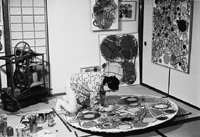
Tanaka working at her house in Myohoji temple. On the floor, Spring 1966.
© Atsuko Tanaka and Akira Kanayama.
Courtesy of Atsuko Tanaka and the Ashiya City Museum of Art & History
1967
OCTOBER 9–15
Atsuko Tanaka Exhibition, Hakusuisha Gallery, Osaka
Works included: 7
All Untitled works from 1966 and 1967
Among them, two are on circular supports, one of which rotates.
1968
AUGUST 26–31
Atsuko Tanaka Exhibition, Akao Gallery, Osaka
Works included: 3 confirmed
Three circular works (1966–68), at least three other paintings, and many small drawings.
OCTOBER
Round on Sand, Awaji Island, Hyo¯go Prefecture
A performance by Tanaka drawing on the beach. Photographer Hiroshi Fukuzawa documents the process in 16-mm film (plate 61).
1969
MAY 10–30
9th Contemporary Art Exhibition of Japan, Tokyo Metropolitan Art Museum
Travels to: Kyoto, Nagoya, Hiroshima, Okayama, Nagasaki, Fukuoka, Kitakyu¯shu¯, and Sasebo
Works included: 1
Gate of Hell included in the first section of works in “Representative Works of Contemporary Art from the Past 20 Years.”
1972
APRIL 11–22
Atsuko Tanaka Exhibition, Minami Gallery, Tokyo
Works included: at least 8 paintings from 1970 to 1972.

Tanaka making Round on Sand, (1968).
© Atsuko Tanaka and Takehiro Nabekura.
Courtesy of Atsuko Tanaka and the Ashiya City Museum of Art & History.
JULY 17–22
Atsuko Tanaka Exhibition, Fujimi Gallery, Osaka
Works included: at least 9 paintings produced between the late 1960s and 1972.
SEPTEMBER
Tanaka and Kanayama move from Osaka
to 176 Kurihara, Asuka-mura, Takaichi-gun, Nara, and live communally with Hiroshi and Yasuko Fukuzawa.
1973
JUNE 12–JULY 29
The Development of Post-War Japanese
Art: The Diversification of Abstraction,
The National Museum of Modern Art,
Tokyo
Works included: 1
Work (1971)
1975
APRIL 7–26
Atsuko Tanaka Exhibition, Kasahara Gallery, Osaka
Works included: 19
Four paintings and fifteen drawings (dates ranging from 1967 to 1975)
1976
NOVEMBER 2–14
18 Years of Gutai Art, Osaka Fumin Gallery, Osaka
Works included: 1
Work (1963)
1978
FEBRUARY 21–27
10th Solo Exhibition of Atsuko Tanaka, Asahi Gallery, Kyoto
1979
JANUARY 5–28
Jiro¯ Yoshihara and Today’s Aspects of the Gutai, Hyo¯go Prefectural Museum of Modern Art, Ko¯be
Works included: 2
‘78C and ‘78D (both 1978)
1980
MARCH 21–29
Atsuko Tanaka Exhibition, Ban Gallery, Osaka
Works included: over 20
One painting (1978) and over twenty gouache drawings from the late 1970s.
1981
SEPTEMBER 12–NOVEMBER 8
Trends of Contemporary Japanese Art 1, the 1950s: Gloom and Shafts of Light, Tokyo Metropolitan Art Museum
Works included: 5
Work (6) (1955, plate 5), Work (Bell)
(1955, plate 15) Plan for “Work”
(Bell), and Untitled, (both 1955, plate 12, 13) and Work (Hoop) (1963)
DECEMBER 4–JANUARY 31, 1982
The 1960s: A Decade of Change in Contemporary Japanese Art, The National Museum of Modern Art, Tokyo
Works included: 1
Work (63) (1963)
Travels to: The National Museum of Modern Art, Kyoto (February 10–March 14)
1982
JANUARY 11–23
New Year’s Exhibition: Atsuko Tanaka, 81 Bijutsukan, Tokyo
Works included: unconfirmed
1983
OCTOBER 11–29
Atsuko Tanaka Exhibition, Gallery Takagi, Nagoya
Works included: 83H (1983), 78i (1978), and others
DECEMBER 10–FEBRUARY 5, 1984
Electra, Musée d’Art Moderne de la Ville de Paris
Works included: 4
Work (Bell) (1955, plate 15) and three Drawing[s] after “Electric Dress” (1956).
1985
APRIL 19–MAY 15
Points and Lines in Spiral: Tanaka Atsuko 1960, The Contemporary Art Gallery, Seibu department store, Tokyo
Works included: 11
All works from the late 1950s to the late 1960s, including Three Black Balls (1962, plate 54).
SEPTEMBER 1–16
Jiro¯ Yoshihara and Gutai, 1954–1972, Ashiya Civic Center
Works included: 2
‘61 (Red and Black) (1961) and Work (64) (1964)
SEPTEMBER 27–NOVEMBER 26
Action et Émotion, Peintures des Années 50: Informel, Gutai, COBRA, The National Museum of Art, Osaka
Works included: 4
Work (6) (1955, plate 5), Dessin (1957), and two Work[s] (1958 and 1961)
NOVEMBER 15–DECEMBER 14
Atsuko Tanaka: Drawings, 1956 to1985, Gallery Takagi, Nagoya
Works included: unconfirmed
Over forty drawings from 1956–1985.
DECEMBER 8–FEBRUARY 9, 1986
Reconstructions: Avant-Garde Art in Japan,
1945–1964, Museum of Modern Art, Oxford
Works included: 4
Work (6) (1955, plate 5), Work (Bell) (1955, plate15), and two paintings (both 1960)
Travels to: Fruitmarket Gallery, Edinburgh (February 22–April 5, 1986)
DECEMBER 21–JANUARY 26, 1986
Grupo Gutai: Pintura y Acción, Museo Español de Arte Contemporáneo, Madrid
Works included: 4
Four Work[s] (1958, 1959, 1960, 1961)
Travels to: Muzej Savremene Umetnosti, Beograd (March 27–May 4, 1986) and The Hyo¯go Prefectural Museum of Modern Art, Ko¯be (August 30–September 28, 1986)
1986
SEPTEMBER 6–20
Atsuko Tanaka Exhibition, Gallery Takagi, Nagoya
Works included: 17
Electric Dress (1956, plate 28), seven drawings related to Electric Dress (1956, plates 33, 34, 36, 41, 42, 43), Untitled (8) (1956, plate 34), four Untitled paintings from the 1960s, four Untitled paintings and two Untitled drawings from the 1980s. The reconstruction of Electric Dress, produced for Japon des avant gardes, 1910–1970, is previewed.
DECEMBER 1–MARCH 2, 1987
Japon des avant gardes, 1910–1970,
Musée national d’art moderne—Centre Georges Pompidou, Paris
Works included: 7
Work (6) (1955, plate 5), Electric
Dress (1956, plate 28), Drawing after “Electric Dress” (1956), Notch (1955,
plate 14), Work (Bell) (1955, plate 15),
Notebook—Atsuko Tanaka I (1956–1963, plate 48), and Three Black Balls (1962,
plate 54).
1987
JANUARY 30–MARCH 7
Atsuko Tanaka: Peintures, Galerie Stadler, Paris
Works included: 13
All Untitled: four paintings from the 1960s, one painting from the 1970s, and eight
paintings from the 1980s.
1988
JANUARY 16–29
Atsuko Tanaka Exhibition, Gallery Temporary
T & I, Kyoto
Works included: 15
All Untitled paintings, primarily from the 1980s.
1990
FEBRUARY 27–APRIL 15
Atsuko Tanaka Exhibition, Kita Art Museum, Nara
Works included: 10
All Untitled paintings, primarily from the 1980s.
APRIL 10–MAY 27
Gutai: The Unfinished Avant-Garde Group, The Sho¯to¯ Museum of Art, Tokyo
Works included: 7
Work (c.1954, plate 4), Work (Bell) (1955, plate 15), Work (6) (1955, plate 5), four Work[s] (c. 1954, 1958, 1960, 1961).
OCTOBER 20–NOVEMBER 22
Atsuko Tanaka Exhibition, Gallery Takagi, Nagoya
Works included: 21
Untitled paintings from 1987 to 1990.
DECEMBER 6–FEBRUARY 28, 1991
Giappone all’avanguardia: Il Gruppo Gutai negli anni cinquanta, Galleria Nazionale d’Arte Moderna, Rome
Works included: 6
Work (Bell) (1955, plate 15), Work (6) (1955, plate 5), Electric Dress (1956, plate 28), three Work[s] (1958, 1959, 1961).
1991
MARCH 24–MAY 5
Gutai: Japanische Avantgarde, 1954–1965, Mathildenhöhe Darmstadt
Works included: 6
Work (Bell) (1955, plate 15), Work (6) (1955, plate 5), Electric Dress (1956, plate 28), three Work[s] (1958, 1959, 1961).
NOVEMBER 27–DECEMBER 14
Atsuko Tanaka, Gallery Kuranuki, Osaka
Works included: 14
Untitled paintings on circular canvases
from 1991.
1992
JUNE 20–AUGUST 2
Gutai 1, Ashiya City Museum of Art &
History, Ashiya
Works included: 23
Two Calendar[s] (both c. 1954, plates 1,2), Work (c.1954, plate 4), two Work[s] (c.1954, 1958), Work (6) (1955, plate 5), Work (Bell) (1955, plate 15), Electric Dress (1956, plate 28), and fifteen Drawing[s] (fourteen from 1956, one from 1957).
1993
JANUARY 5–FEBRUARY 14
Gutai 2: 1959–1965, Ashiya City Museum of Art & History, Ashiya
Works included: 3
Two Work[s] (1962 and 1963), and Work (1964).
JUNE 13–OCTOBER 10
La Biennale di Venezia: XLV Esposizione Internazionale d’Arte, Passaggio ad Oriente, Venice
Works included: 2
Work (Pink Cloth) (1955, reconstructed in 1993) and Stage Clothes (1956, reconstructed in 1993)
OCTOBER 15–DECEMBER 19
Gutai 1955/56: A Restarting Point for Japanese Contemporary Art, Penrose Institute of Contemporary Arts, Tokyo
Works included: 10
Work (Bell) (1955, plate 15), Electric Dress (1956, plate 28), Plan[s] for “Work” (Bell) (1955, plates 12, 13), and seven Drawing[s] (all 1956).
Travels to: Kirin Plaza Osaka, Osaka (February 22–March 31, 1994)
1994
FEBRUARY 5–MARCH 30
Japanese Art after 1945: Scream Against the Sky, Yokohama Museum of Art, Yokohama
Works included: 7
Work (6) (1955, plate 5), four Untitled—Study for “Work” (Bell) (1955, plates 9, 10, 11, 12), Plan for “Work” (Bell) (1955, plate 13), Electric Dress (1956, plate 28), and Work (1958).
Travels to: the San Francisco Museum of Modern Art with the Yerba Buena Center for the Arts, San Francisco (May 31–August 27), and the Guggenheim Museum SoHo, New York (September 14–January 8, 1995).
MARCH 23–APRIL 22
Atsuko Tanaka Exhibition, LADS Gallery, Osaka
Works included: 12 works from the late 1970s to the late 1980s
OCTOBER 7–NOVEMBER 30
Atsuko Tanaka Exhibition, Gallery Takagi, Nagoya
Works included: 18 works from the 1990s
1995
APRIL 19–JUNE 4
The Trajectory of Post-War Culture, Meguro Museum of Art, Tokyo
Travels to: Hiroshima City Museum of Contemporary Art, Hiroshima, Hyo¯go Prefectural Museum of Modern Art, Ko¯be, and Fukuoka Prefectural Museum of Art, Fukuoka.
Works included: 1
Work (1960)
1996
JUNE 8–JULY 21
Shedding Light on Art in Japan: 1953, Meguro Museum of Art, Tokyo
Works included: 4
Two Calendar[s] (both c. 1954, plates 1, 2), Work (c.1954, plate 4) and Work (c. 1954).
1997
MARCH 13–JUNE 1
Torino Parigi New York Osaka. Tapié. Un Art Autre, Galleria Civica d’Arte Moderna e Contemporanea, di Torino, Turin
Works included: 2
Both titled Work (both 1960)
Travels to: Espace d’Art Moderne et Contemporain de Toulouse et Midi Pyrénées (September 22–November 23).
1998
FEBRUARY 8–MAY 10
Out of Actions: Between Performance and
the Object, 1949–1979, The Museum of Contemporary Art at The Geffen Contemporary, Los Angeles
Works included: 17
Electric Dress (1956, plate 28), fifteen Drawing[s] (fourteen from 1956, one from 1957), Drawing after “Electric Dress” (1956).
Travels to: MAK-Austrian Museum of Applied Arts, Vienna (June 17–September 6, 1998); Museu d’Art Contemporani de Barcelona, Barcelona (October 15–January 6, 1999); and Museum of Contemporary Art, Tokyo (February 11–April 11, 1999).
FEBRUARY 21–MARCH 28
Atsuko Tanaka: The Bell Rings—Early Objets and Drawings, Gallery HAM, Nagoya
Works included: number unconfirmed
Three-dimensional objets and drawings from 1954 to 1956, two paintings from the 1960s, two paintings from the 1970s and 1980s, two paintings from the 1990s. Many early works, including Work[s] (Yellow Cloth) (1955, plates 6, 7, 8) are exhibited for the first time since the 1950s.
SUMMER
Atsuko Tanaka: Another Gutai
Documentary video, part of the Ufer!Art Documentary series. Directed by Aomi Okabe and photographed and edited by Yasushi Kishimoto (45 minutes, colour).
OCTOBER 8–JANUARY 11, 1998
Addressing the Century: 100 Years of Art and Fashion, Hayward Gallery, London
Works included: 7
Four Drawing[s] after “Electric Dress” (all 1956, plates 38, 39, 40), Study for “Stage Clothes” (c.1956, plate 22), Work (1956, plate 20), and an 8-millimetre film of Stage Clothes (1957).
Travels to: Kunstmuseum Wolfsburg (February 26–May 23, 1999)
OCTOBER 17–NOVEMBER 29
So¯getsu and Its Era, 1945–1970, Ashiya City Museum of Art & History, Ashiya
Works included: 1
Work (1958)
Travels to: Chiba City Museum of Art (December 5–January 10, 1999)
1999
FEBRUARY 11–MARCH 22
Art/Domestic: Temperature of the Time, Setagaya Art Museum, Tokyo
Works included: 18
86G, 87H, 91B, 93D, 93G, 94B, 95A, 95C, 97C, 97c, 98A, and 98a, as well as six drawings from the 1980s and1990s.
MAY 4–JUNE 27
Gutai, Galerie Nationale du Jeu de Paume, Paris
Works included: 19
Work (c. 1954, plate 3), Work (c.1954), Work (c.1954, plate 4), Work (6) (1955, plate 5), seven Drawing[s] after “Electric Dress” (all 1956, plates 41, 42, 43, 44, 45, 46, 47), a reconstruction of Electric Dress (2000), seven Work[s] (one each from c. 1954, 1957, 1958, 1962, 1963, and
two from 1961), and Work (1964).
2000
DECEMBER 2–FEBRUARY 15, 2001
Tanaka Atsuko, 1998–2000: Recent Works, Gallery HAM, Nagoya
Works included: 39
Twenty-eight paintings and eleven drawings from 1999 and 2000.
2001
MARCH 3–MAY 6
Atsuko Tanaka: Search for an Unknown Aesthetic, 1954–2000, Ashiya City Museum of Art & History, Ashiya
Works included: 145 works and related documents from 1954 to 2000.
Included in this first museum retrospective: four works are reconstructed, including Work (Bell) and Stage Clothes.
Travels to: Shizuoka Prefectural Museum of Art, Shizuoka (July 28–September 9)
OCTOBER 4–DECEMBER 9
Facts of Life: Contemporary Japanese Art, Hayward Gallery, London
Works included: 3
‘91A (1991), ‘99I (1999), and ‘94B (1994)
2002
FEBRUARY 8–MARCH 2
Atsuko Tanaka: Paintings of 2000, Tomio Koyama Gallery, Tokyo
Works included: 12
Seven paintings and five drawings from 1999–2000.
FEBRUARY 16–APRIL 6
Atsuko Tanaka: Circle, Circle, Circle, Gallery HAM, Nagoya
Works included: 14
Eleven paintings on circular canvases and three drawings (all 1991).
FEBRUARY 23–MARCH 30
Atsuko Tanaka in Kyoto, Mori Yu Gallery, Kyoto
Works included: 18
One painting (1968), seven paintings and one drawing from the 1980s and1990s, and one painting and eight drawings
from 2001.
SEPTEMBER 7–NOVEMBER 3
Atsuko Tanaka, Galerie im Taxispalais, Innsbruck, Austria
Works included: 38 works and related
documents from the 1950s and 1960s.
2003
NOVEMBER 22–JANUARY 31, 2004
Atsuko Tanaka, New Paintings: 2002–2003, Gallery HAM, Nagoya
Works included: 20
Nineteen paintings from 2001–2003, and one drawing from 2001.
2004
JANUARY 24–MARCH 14
Gutai Retrospective, Hyo¯go Prefectural Museum of Art, Ko¯be
Works included: 11
Work (6) (1955, plate 5), Work (Bell) (1955, plate15), Electric Dress (1956, plate 28), five drawings from 1956, one drawing from 1957, Work (Cross) reconstructed for this exhibiton (1956, fig. 7), and Work (1958).











 Tanaka standing in front of the first floor window of the office building of
Tanaka standing in front of the first floor window of the office building of 




